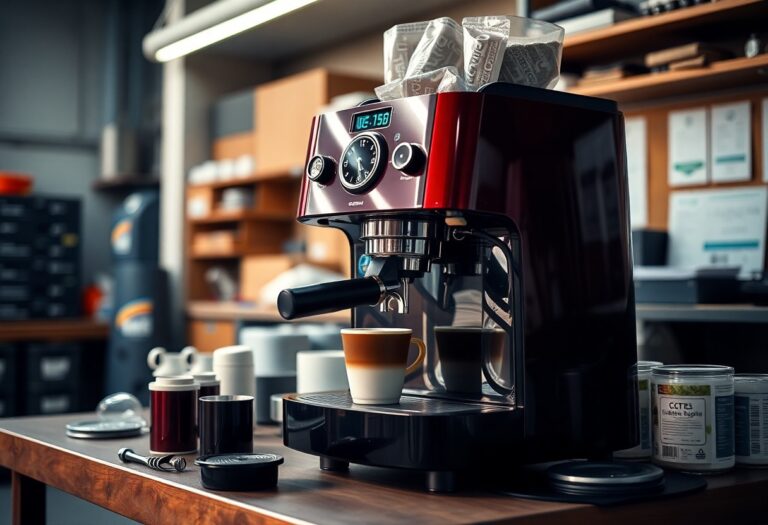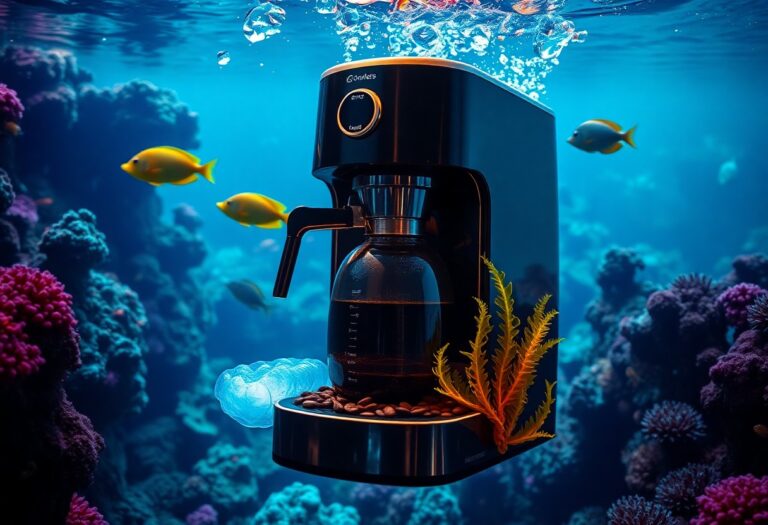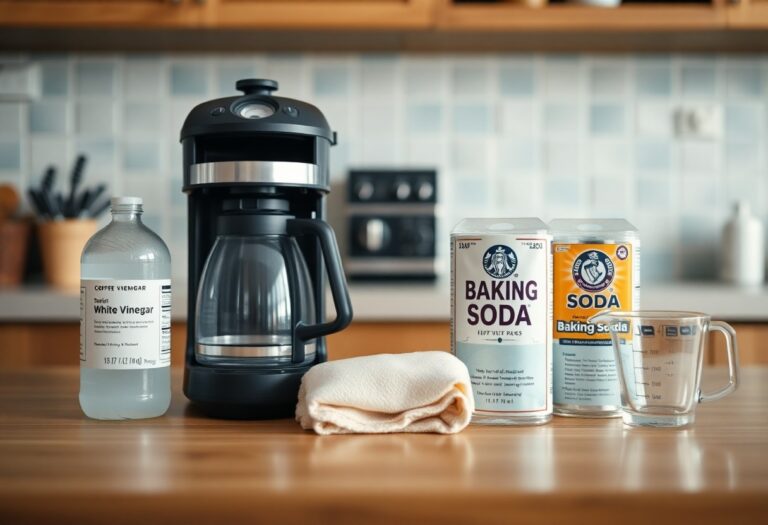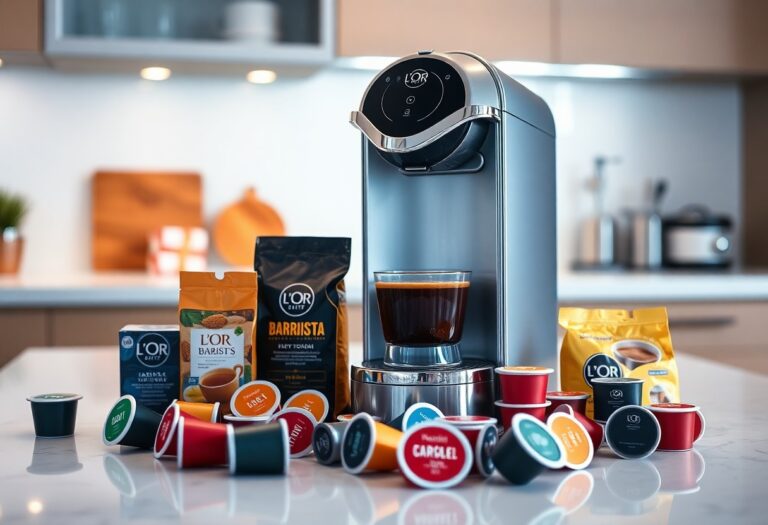How to Operate a Coffee Machine – Basic Instructions
Most coffee enthusiasts find that operating a coffee machine can seem daunting at first, but with the right guidance, you can brew your perfect cup effortlessly. In this post, you’ll learn simple steps to ensure your coffee machine runs safely and effectively, enhancing your morning routine. Follow along closely to avoid common mistakes and enjoy the rich flavors of freshly brewed coffee. By understanding your machine’s features and proper usage, you’ll not only save time but also unlock the full potential of your coffee experience.
Key Takeaways:
- Ensure the coffee machine is clean and properly set up before use.
- Measure and add the appropriate amount of coffee grounds and water based on the machine’s instructions.
- Choose the correct brewing cycle or settings for the type of coffee desired.
- Allow the machine to complete the brewing process without interruption for best results.
- After brewing, clean the machine and store it properly to maintain functionality.

Choosing the Right Coffee Machine for Your Needs
Selecting the perfect coffee machine depends on your preferences, brewing style, and budget. You should consider factors such as the type of coffee you enjoy, how often you brew, and whether you value convenience or traditional methods. Knowing what you want will guide you to a machine that meets your expectations, ensuring your daily coffee ritual delights you.
Analyzing Different Coffee Machine Types
Exploring various coffee machine types helps narrow down your choices to find the best fit for you.
| Type | Description |
| Drip Coffee Maker | Brews multiple cups at once, ideal for families. |
| Single-Serve Machines | Quick and convenient, perfect for single servings. |
| Espresso Machines | Offers a rich and intense coffee experience. |
| French Press | Manual method producing full-bodied coffee. |
| Pour-Over | Allows control over brewing time and extraction. |
Key Features to Look For
Identifying the key features in a coffee machine can significantly enhance your brewing experience.
- Ease of Use – Simple controls save time and effort.
- Size – Ensure it fits your kitchen space and brewing volume.
- Durability – Invest in a machine that lasts through daily use.
- Versatility – Some machines can brew various coffee styles.
- Cleaning and Maintenance – Machines with easy-clean features simplify upkeep.
Understanding the key features can make a significant difference in your coffee-drinking experience. Examples include the ease of use which allows you to brew quickly, and size considerations for your kitchen space. A durable machine protects your investment, while versatility adds options for brewing. Cleaning features play a pivotal role in maintaining your machine. Assume that pairing these attributes with your personal preferences results in a satisfying brewing experience.
Prepping for Brewing: The Essential Setup
Preparing your coffee machine for brewing is a vital step in ensuring that each cup you make is flavorful and satisfying. Begin by gathering all necessary ingredients and tools, including freshly ground coffee, filtered water, and your favorite accessories like a coffee scoop or scale. Make sure your workspace is clean and organized, which makes the brewing process smoother and more enjoyable.
The Importance of Fresh Ingredients
Using fresh ingredients can dramatically enhance the flavor profile of your coffee. Freshly roasted coffee beans contain vital oils that contribute to the aroma and taste. Aim to use beans roasted within the last two weeks and grind them just before brewing for optimal freshness. Similarly, filtered water devoid of chlorine or impurities will elevate your cup, highlighting the coffee’s delicious notes.
Setting Up Your Coffee Machine Properly
Correctly setting up your coffee machine ensures a consistent brewing process and rich flavor extraction. Begin by checking the machine’s water reservoir and filling it with filtered water to avoid off-flavors. Next, install a clean coffee filter if your machine requires it, setting the filter correctly to prevent grounds from slipping through. Adjust the machine’s settings according to the type of coffee you’re brewing, such as selecting the right brew size and temperature for optimal extraction.
Taking a few moments to set up your coffee machine properly can significantly impact your brewing results. For instance, ensure that the temperature dial is set correctly, typically between 195°F and 205°F, for optimal flavor extraction. If your machine has a built-in grinder, calibrate it according to your coffee bean’s coarseness. Ensuring the correct coffee-to-water ratio—usually 1:15—will consistently yield a well-balanced cup. Regular machine maintenance, such as descaling and cleaning, also helps preserve the quality of your brew and extends the machine’s lifespan for many brewing adventures ahead.
Brewing Techniques: Mastering the Perfect Cup
Achieving the perfect cup of coffee involves mastering various brewing techniques. Each method brings out unique flavors and aromas, catering to your preferences. Whether you’re using a French press, pour-over, or drip coffee maker, understanding the nuances of water temperature, grind size, and brewing time is important for extracting the best characteristics from your coffee beans.
Understanding Brewing Ratios and Timing
Brewing ratios play a significant role in crafting a flavorful cup. The standard ratio is generally 1:16, meaning one part coffee for every sixteen parts water. This ratio can be adjusted based on your taste preferences. Additionally, timing affects extraction; most methods recommend a brew time of 4 to 5 minutes, but experimentation with timing can help find that sweet spot that suits your palate.
Tips for Achieving Optimal Flavor Extraction
Optimal flavor extraction is about finding balance. Start with fresh, high-quality coffee beans, ensuring they are appropriately ground for your chosen brewing method. Water temperature between 195°F and 205°F helps extract flavors without scalding the coffee. Experiment with pulse pouring techniques for pour-over methods or shaking the French press before steeping to promote an even extraction. Lastly, don’t shy away from adjusting your brew time or ratio slightly based on your taste feedback.
- fresh coffee beans
- grind size
- extraction
To enhance flavor extraction, explore the coffee variety and region, as different beans have distinct profiles. Always measure your coffee and water precisely for consistent results, and consider the brewing environment—fresh filtered water can make a noticeable difference in taste. Keep records of your trials to refine your technique over time. Assume that your experimentation will lead to discovering your ideal brewing method.
- measuring
- brewing environment
- consistently

Maintenance and Troubleshooting: Keeping Your Machine in Top Shape
Regular maintenance not only prolongs the lifespan of your coffee machine but also ensures that every cup delivered is rich in flavor and aroma. Schedule frequent cleanings to remove coffee residues and mineral buildup, and do not overlook the importance of descaling your machine as water quality varies. For detailed guidance on using and caring for your coffee maker, visit How to Use a Coffee Maker: 15 Steps (with Pictures).
Regular Cleaning and Maintenance Routines
Establish a cleaning schedule that fits your usage frequency. For machines used daily, a weekly wipe-down and monthly deep cleaning are advisable. Ensure to wash the carafe and filter basket after each use to prevent residue buildup. Don’t forget to check and clean the water reservoir regularly, as stagnant water can lead to unwanted tastes and odors.
Common Issues and Their Solutions
Encountering issues with your coffee machine can be frustrating, yet most common problems have straightforward solutions. If your coffee is brewing too slowly, try cleaning the filter basket and ensuring it’s not clogged. Should the machine fail to start, check the power cord and plug, as well as any fuse or circuit breaker issues. Additionally, if you notice an unusual taste in your coffee, it may be time to run a descaling solution through your machine.
Common issues such as brewing inconsistencies often stem from simple glitches. For example, if your coffee isn’t hot enough, verify that you’re using fresh grounds, as old coffee beans can affect brew temperature and flavor. A malfunctioning heating element might also be the culprit in certain models. Cleaning the machine regularly and using filtered water can minimize these issues, ensuring your coffee remains perfect with every brew.
The Coffee Lover’s Guide: Elevating Your Experience
Elevating your coffee experience goes beyond just brewing. It’s about exploring different flavors, brewing methods, and pairing your favorites with delicious foods. This journey transforms your daily coffee ritual into a delightful experience that sharpens your palate and enhances your enjoyment. Engaging your senses through various techniques and pairings invites you to discover new dimensions in every cup.
Experimenting with Different Coffee Beans and Techniques
Dive into the vast world of coffee by experimenting with various bean origins and roasting profiles. Each region offers unique flavor notes, such as Ethiopian beans with bright floral hints or Brazilian varieties delivering rich chocolate tones. Play with different brewing techniques like French press or pour-over to unveil new subtleties in flavor. Don’t hesitate to adjust grind sizes, water temperatures, and brew time to fine-tune your brew.
Pairing Your Coffee with Food for Enhanced Enjoyment
Unlock the full potential of your coffee by thoughtfully pairing it with food. The right pairing can accentuate flavors and create a harmonious balance. For example, a rich espresso goes beautifully with a dark chocolate dessert, enhancing the chocolate’s bitterness while complementing the coffee’s depth. On the other hand, light-roasted coffees can be delightful with fruity pastries, where the coffee’s brightness mirrors the sweetness of fresh fruit.
Exploring coffee and food pairings opens a realm of taste sensations. Consider a savory breakfast of avocado toast alongside a smooth medium roast, where the coffee’s subtle nuttiness enhances the creamy avocado. Alternatively, indulge in a classic combination like a rich cappuccino with buttery croissants for a comforting start to your day. Matching flavors helps you discover how coffee can elevate your culinary experiences, creating moments of pure enjoyment.
To wrap up
Following this guide, you now have the imperative knowledge to operate a coffee machine effectively. By understanding the key components and steps involved—from measuring your coffee grounds to adjusting brewing settings—you’re well on your way to enjoying a perfect cup every time. Don’t hesitate to experiment with different types of beans and brew methods to find your ideal flavor profile, ensuring your coffee experience is both enjoyable and rewarding.
FAQ
Q: What are the basic components of a coffee machine that I should be familiar with?
A: A typical coffee machine consists of several key components including the water reservoir, filter basket, carafe or pot, control panel, and heating element. The water reservoir holds the liquid that will be heated and brewed into coffee. The filter basket is where you place the coffee grounds along with a paper or reusable filter. The carafe collects the brewed coffee, while the control panel allows you to set the brewing options and start the machine. Understanding these parts will help you operate your coffee machine more effectively.
Q: How do I start the coffee brewing process?
A: To start the coffee brewing process, first make sure the coffee machine is plugged in and turned on. Fill the water reservoir with fresh water, using the recommended amount specified by the machine (usually indicated in cups). Next, place a coffee filter in the filter basket and add the desired amount of ground coffee. After setting the coffee strength or brew time, press the brew button to begin the process. The machine will heat the water and pass it through the coffee grounds, extracting flavor and aroma.
Q: How can I clean and maintain my coffee machine?
A: Regular cleaning and maintenance are imperative for ensuring your coffee machine brews great-tasting coffee. Start by unplugging the machine and allowing it to cool down. Remove and wash the carafe, filter basket, and any removable parts in warm, soapy water. You can also run a mixture of equal parts water and white vinegar through the machine to clean the internal components. After that, run two cycles of plain water to rinse out any vinegar residue. It’s advisable to clean your machine regularly to prevent buildup and maintain flavor.
Q: What types of coffee grounds can I use in my coffee machine?
A: Most coffee machines can accommodate pre-ground coffee that is suitable for drip brewing. You can use regular ground coffee, coarse ground coffee for a lighter flavor, or finely ground coffee for a stronger brew. However, avoid using espresso finely ground coffee unless your machine is specifically designed for it, as it can clog the filter basket. Always check the manufacturer’s guidelines for recommended coffee grounds and brewing methods for your specific machine.
Q: How do I troubleshoot common issues with my coffee machine?
A: Common issues with coffee machines may include dripping, overheating, or failure to brew. If your machine is dripping, ensure that the carafe is correctly placed and that the filter basket is not overfilled. If the machine overheats, check if it has an automatic shut-off feature that kicks in after some time. For a machine that fails to brew, check if it has enough water in the reservoir and that the coffee grounds are appropriately packed. If problems persist, consult the user manual for specific troubleshooting steps or contact customer support.







